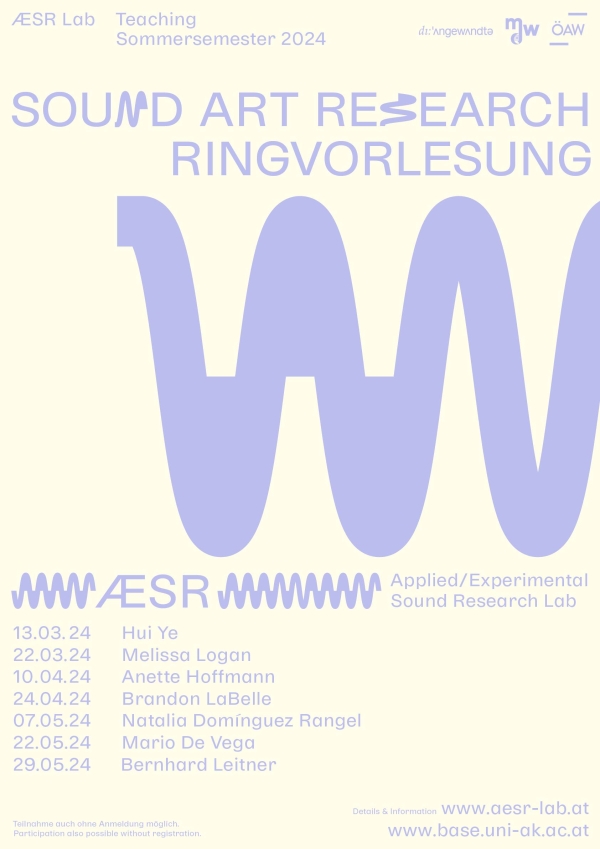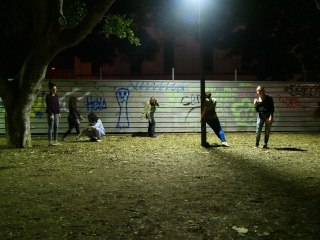The lecture is part of the
ÆSR
Lab - Applied/Experimental Sound Research Laboratory. ÆSR Lab is a cooperation project of the University of Applied Arts
Vienna (Centre Focus Research) and the Artistic Research Center (ARC), the Institute for Composition, Electroacoustics and
Tonmeister:innen-Ausbildung (IKE) of the mdw - University of Music and Performing Arts Vienna and the Phonogrammarchiv of
the Austrian Academy of Sciences. ÆSR Lab is funded by the BMBWF and in co-operation with the Recovery and Resilience Facility
(RRF) of the EU.
Mario de Vega : “Artist Talk"Through
relations between energies and systems produced by induced situations, electronic interfaces and architectonic interventions,
Mario de Vega's work evokes listening settings whether the body still listening, or only believes to listen.
His
work has been exhibited in Mexico, North America, Chile, South Africa, India, South Korea, China, Russia, Japan and in multiple
contexts througout Europe. He has been guest artist and lecturer at City University of Hong Kong, Universität der Künste Berlin,
Rijksakademie Amsterdam, Internationales Musikinstitut Darmstadt, Technische Universität Berlin, Ecole Nationale Supérieure
des Beaux Arts de Paris, Kyushu University, écal and Centro among others.
Since 2020, Mario de Vega is Professor
at the Kunsthochschule Kassel.
https://mariodevega.info /
https://ftp-direct.media
Natalia Domínguez Rangel : “Exploring the Intersection of sound in sculpture”
In
her research, the focus lies on highlighting how critical listening can establish connections across various acoustic ecologies
beyond human-generated sounds. The intertwining of sound and sculpture is a central theme, with sculptures envisioned as dynamic
acoustic "sanctuaries" rather than static forms, designed to encapsulate unique sound concepts and recordings. By blurring
the boundaries between sound and form, her works invite viewers to immerse themselves in a realm where tangible art transcends
into the ethereal, triggering imagination and inviting contemplation of materiality, spatiality, memory, temporality, and
expression. Through a feminist lens, emphasis is placed on body autonomy, empowerment, inclusivity, and solidarity, advocating
for silenced voices and a broader exploration of acoustic agency. The sculptures utilize sonic memories, archives and materials
with sonic qualities, integrating a variety hardwares to create specific sonic experiences within the artwork, ultimately
encouraging critical listening and a deeper understanding of our interconnectedness with the environment.
Natalia
Domínguez Rangel is a Colombian/Dutch visual artist and music composer currently living and working in Vienna and
Amsterdam. Her practice includes making sculptures, installations, and performances, her work delves into the intersection
of sound and sculpture.
Domínguez Rangel has exhibited her works throughout Europe and Latin America in various contexts,
from festivals, to galleries, museums and interventions in public spaces. She is a docent in the field of sound studies since
2017 at Design Art Technology department of ArtEZ, Arnhem, NL. Domínguez Rangel is also the winner of the music composition
prize Tera de Marez Oyens in The Netherlands. Has taught and give lectures at Universität für Musik und Darstellende Kunst
(mdw), Die Angewandte and the Akademie der bildenden Künst in Vienna (AT), Kunstuniversität Linz, Skulptur Linz w/Gelitin.
Future lectures planned at the department of Sound Art at Columbia University in New York (USA).
Anette
Hoffmann: “Knowing by Ear”
Albert Kudjabo (DRC) and Stephan Bischoff (Togo) both produced recordings with
German linguists in POW camps of World War I (1917). Their spoken texts comment on colonial extraction and the violent practices
of the mission. These recordings were archived more than a century ago, but did not enter public spaces so far.
Albert
Kudjabo connected the colonial extraction of Gold in Kilo and its dramatic impact on the livelihoods in the region to gender
relations; Stephan Bischoff, who grew up in a mission station, mentioned the historical destruction of a shrine in Krachi
(now Ghana) by German military. Anette Hoffmann follows these archival traces in her new book Knowing by Ear. Creating two
installations with the recordings she also seeks to produce translations of those opaque texts, which can speak to a wider
public and thus undo the sequestration of colonial sound archives. In her lecture she introduces her work on sound collections
in terms of research and artistic practice.
Mel E Logan (VooCha, Chicks on Speed, UniCAT Records)
stepped into electronic music producing and writing while studying painting at the Akademie Der Bildenden Künste München.
Logan's practice of painting, music and performance comes together as audio sculptures with which the visitors perform the
music, working with a hybrid format floating between a sound player and instrument building. Electromagnetism and the motion
of the human body, motions of data are subjects Logan's work deals with in a direct, partially analogue format where machines
are extensions of humanities superpowers.
With a focus on the social-political aspects of the acts of listening and
vocalizing, Hui Ye’s recent projects delve into the entanglement between the auditory dimension of collective memory and the
(institutional) writing of history. In addition to examining the structural narrative of personal emotions influenced by sonic
culture, her research also centers on the subject matter of the (digitalized) voice in exploring the intersection of identities,
spirituality, and the oral interaction between human and machine.
As a founder of Chicks on Speed, Logan has exhibited
and performed at the Pompidou, Tate Britain, Beirut Art Center, Moog Lab Trinity College Dublin, Museum Tinguely Basel, Art
Science Museum Singapore, MoMA PS1, the Royal Festival Hall London UK and the ZKM Centre for Art and Media, Karlsruhe. Mel
E. Logan's artworks are in the (selected) collections of Agustin Sanchez Vidal, Madrid ES, Dr. Stephanie Bohn, Bonn DE, Museum
für Kommunikation Frankfurt DE, and the Museum of New Zealand Te Papa Tongarewa, NZ.
At the Angewandte her lectures
span from theory to action and back again.
Hui Ye (born in Guangzhou, CN) is an artist and composer
based in Vienna. She works with different media including experimental documentary, video and audio installation, and often
address the social-political aspect of the act of listening and the ever-changing process of individuals’ social identity,
alongside its manifestation in technology and sonic culture. In her most recent projects, the subject matter of the (digitalised)
voice is essential for her research. Hui Ye is laureate of the Kunsthalle Wien Prize 2018 and a co-founder of Mai Ling – a
queer-feminist Asian artists collective. Her works have been recently presented at Kunsthalle Wien, Vienna Secession, Belvedere
21 (AT), the Jim Thompson Art Center (TH), Lothringer 13 (GE), WRO Media Art Biennial (PL) and the Timesmuseum Guangzhou (CN).
Hui Ye | 葉慧
yehui.org
The RINGVORLESUNG Sound Art Research is
part of the ÆSR Lab - Applied/Experimental Sound Research Laboratory. ÆSR Lab is a cooperation project of the University of
Applied Arts Vienna (Centre Focus Research) and the Artistic Research Center (ARC), the Institute for Composition, Electroacoustics
and Tonmeister:innen-Ausbildung (IKE) of the mdw - University of Music and Performing Arts Vienna and the Phonogrammarchiv
of the Austrian Academy of Sciences. ÆSR Lab is funded by the BMBWF and in co-operation with the Recovery and Resilience Facility
(RRF) of the EU.





